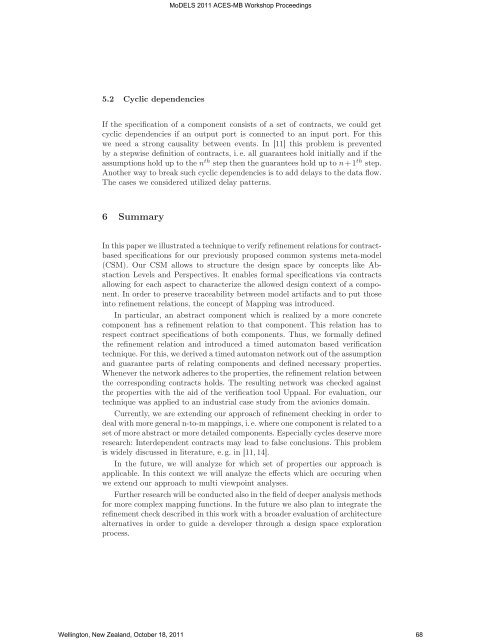A Refinement Checking Technique for Contract-Based Architecture ...
A Refinement Checking Technique for Contract-Based Architecture ...
A Refinement Checking Technique for Contract-Based Architecture ...
You also want an ePaper? Increase the reach of your titles
YUMPU automatically turns print PDFs into web optimized ePapers that Google loves.
5.2 Cyclic dependencies<br />
If the specification of a component consists of a set of contracts, we could get<br />
cyclic dependencies if an output port is connected to an input port. For this<br />
we need a strong causality between events. In [11] this problem is prevented<br />
by a stepwise definition of contracts, i. e. all guarantees hold initially and if the<br />
assumptions hold up to the n th step then the guarantees hold up to n +1 th step.<br />
Another way to break such cyclic dependencies is to add delays to the data flow.<br />
The cases we considered utilized delay patterns.<br />
6 Summary<br />
MoDELS 2011 ACES-MB Workshop Proceedings<br />
In this paper we illustrated a technique to verify refinement relations <strong>for</strong> contractbased<br />
specifications <strong>for</strong> our previously proposed common systems meta-model<br />
(CSM). Our CSM allows to structure the design space by concepts like Abstaction<br />
Levels and Perspectives. It enables <strong>for</strong>mal specifications via contracts<br />
allowing <strong>for</strong> each aspect to characterize the allowed design context of a component.<br />
In order to preserve traceability between model artifacts and to put those<br />
into refinement relations, the concept of Mapping was introduced.<br />
In particular, an abstract component which is realized by a more concrete<br />
component has a refinement relation to that component. This relation has to<br />
respect contract specifications of both components. Thus, we <strong>for</strong>mally defined<br />
the refinement relation and introduced a timed automaton based verification<br />
technique. For this, we derived a timed automaton network out of the assumption<br />
and guarantee parts of relating components and defined necessary properties.<br />
Whenever the network adheres to the properties, the refinement relation between<br />
the corresponding contracts holds. The resulting network was checked against<br />
the properties with the aid of the verification tool Uppaal. For evaluation, our<br />
technique was applied to an industrial case study from the avionics domain.<br />
Currently, we are extending our approach of refinement checking in order to<br />
deal with more general n-to-m mappings, i. e. where one component is related to a<br />
set of more abstract or more detailed components. Especially cycles deserve more<br />
research: Interdependent contracts may lead to false conclusions. This problem<br />
is widely discussed in literature, e. g. in [11, 14].<br />
In the future, we will analyze <strong>for</strong> which set of properties our approach is<br />
applicable. In this context we will analyze the effects which are occuring when<br />
we extend our approach to multi viewpoint analyses.<br />
Further research will be conducted also in the field of deeper analysis methods<br />
<strong>for</strong> more complex mapping functions. In the future we also plan to integrate the<br />
refinement check described in this work with a broader evaluation of architecture<br />
alternatives in order to guide a developer through a design space exploration<br />
process.<br />
Wellington, New Zealand, October 18, 2011 68
















